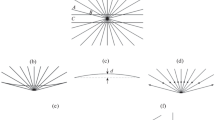Abstract
Studies of the Poggendorff illusion (a transversal interrupted by parallel lines) showed that illusory effects increased linearly with increasing separation between the parallels, increased in inverse proportion to the tangent of the angle of intersection between transversal and parallels, decreased whenever line segments (other than a transversal segment) were omitted, decreasing to zero when the segment of a parallel forming the obtuse angle with the transversal was omitted, and varied systematically with the tilt of the whole display, approaching zero when the transversal was oriented in a horizontal or vertical position. Hypothesis: The Poggendorff illusion involves at least three kinds of effects on the perceived orientation of a segment: distortion by other segments (especially a segment intersecting at an obtuse angle), stability of vertical and Horizontal orientations, and assimilation towards vertical or horizontal.
Similar content being viewed by others
References
CHIANG, C. A new theory to explain geometrical illusions produced by crossing lines. Perception & Psychophysics, 1968, 3, 174–176.
CORNSWEET, T. N. The stair-case method in psychophysics. American Journal of Psychology, 1962, 75, 485–491.
DEUTSCH, J. A. Neurophysiological contrast phenomena and figurai aftereffects. Psychological Review, 1964, 71, 19–26.
DIXON, W. J., & MASSEY, F. J.Introduction to statistical analysis. (2nded.) New York: McGraw-Hill, 1957.
GANZ, L. Mechanism of the figurai aftereffects. Psychological Review, 1966, 73, 128–150.
GREEN, R. T., & HOYLE, E. M. The influence of spatial orientation on the Poggendorff illusion. Acta Psychologica, 1964, 22, 348–366.
KAPPAUF, W. E. Empirical modifications in the up-and-down method and its estimates of μ and σ. Report No. 2, Grant NB-05576-01, Department of Health, Education and Welfare, May 16, 1967.
KAPPAUF, W. E. An empirical sampling study of the Dixon and Mood statistics for the up-and-down method of sensitivity testing. American Journal of Psychology, 1969, 82, 40–55.
LEIBOWITZ, H., & TOFFEY, S. The effect of rotation and tilt on the magnitude of the Poggendorff illusion. Vision Research, 1966, 6, 101–103.
OBONAI, T. Experimentelle Untersuchungen über den Aufbau des Sehraumes. Archiv für die gesamte Psychologie, 1931, 82, 308–328. (Discussed by Obonai, T., Japanese studies on the so-called geometrical-optical illusions. Psychologia, 1960, 3, 7-20).
OVER, R. Explanations of geometrical illusions. Psychological Bulletin, 1968, 70, 545–562.
OYAMA, T. The effect of hue and brightness on the size illusion of concentric circles. American Journal of Psychology, 1962, 75, 45–55.
RESTLE, F. Illusions of bent line. Perception & Psychophysics, 1969, 5, 273–274.
WEINTRAUB, D. J., WILSON, B. A., GREENE, R. D., & PALMQUIST, M. J. Delboeuf illusion: Displacement versus diameter, arc deletions, and brightness contrast. Journal of Experimental Psychology, 1969, 80, 503–511.
WEINTRAUB, D. J., & VIRSU, V. The misperception of angles: Estimating the vertex of converging line segments. Perception & Psychophysics, 1971, 9, 5–8.
Author information
Authors and Affiliations
Additional information
We thank Anita Caplan, Lillian Tong, and Jack Loomis for serving as Es and offering many insights, suggestions, and criticisms. The investigators were supported in part by a United States Public Health Service Research Scientist Development Award (K2-MH-35.253) to the first author from the National Institute of Mental Health. Research funds were provided by National Science Foundation Grants GB3110, GB4947, GB8181, and the University of Michigan’s Biomedical Sciences Institutional Support Grant PHS FR 07050-03.
Rights and permissions
About this article
Cite this article
Weintraub, D.J., Krantz, D.H. The Poggendorff illusion: Amputations, rotations, and other perturbations. Perception & Psychophysics 10, 257–264 (1971). https://doi.org/10.3758/BF03212818
Accepted:
Published:
Issue Date:
DOI: https://doi.org/10.3758/BF03212818




